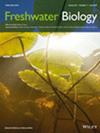Different Approaches to Measuring Diversity Affect the Strength of the Relationship Between Biodiversity and Ecosystem Function in Freshwater Studies: A Meta-Analysis
IF 2.8
2区 生物学
Q2 ECOLOGY
引用次数: 0
Abstract
- The notion that biodiversity begets greater ecosystem functioning is an enduring paradigm in ecology, supported by a growing body of research demonstrating the significant effects of biodiversity on ecosystem functioning (BEF). These studies use several diversity metrics, which can be estimated through taxonomic, functional and molecular approaches.
- Here we aim to investigate the performance of different approaches (taxonomic, functional and molecular), considering the different biodiversity metrics in each approach (e.g., richness, composition, among others). Additionally, we assess the individual response of ecosystem processes (e.g., productivity, decomposition, among others) to biodiversity in each approach. To this end, we perform a review and meta-analysis of studies that assessed BEF relationship in continental aquatic environments, encompassing 94 studies and 322 effect sizes. Our data set includes diverse contexts, with different organisms, environments and ecosystem processes.
- We found an overall positive association between biodiversity and the functioning of continental aquatic ecosystems (Effect size = 0.37). We also found differences in the proportions of biodiversity metrics applied in the studies between the different approaches, as well as some geographic bias, with a predominance of studies conducted in the northern hemisphere. Additionally, lakes were the most commonly studied systems, and productivity functions were frequently analysed. We found that the molecular approach, applied exclusively in microbial studies in our dataset, showed better performance in evaluating the BEF relationship.
- Despite the strengths of the molecular approach, it is not without limitations. Some challenges such as high costs of sequencing and maintaining database infrastructure, can hinder its application. In light of these limitations, we understand that applying functional approaches, specifically functional richness and functional evenness metrics, in the study of the BEF relationship in continental aquatic ecosystems is promising. This can be an alternative for the continuity and advancement of studies of the BEF relationship in these environments. We also highlighted the need for studies in the southern hemisphere, covering the different freshwater ecosystem and multiple functions.
不同测量方法对淡水研究中生物多样性与生态系统功能关系强度的影响:一项荟萃分析
生物多样性产生更大的生态系统功能的概念是生态学中一个持久的范式,越来越多的研究表明生物多样性对生态系统功能的显著影响(BEF)。这些研究使用了几种多样性指标,可以通过分类、功能和分子方法来估计。在这里,我们的目标是研究不同方法(分类、功能和分子)的性能,考虑到每种方法中不同的生物多样性指标(如丰富度、组成等)。此外,我们还评估了每种方法中生态系统过程(如生产力、分解等)对生物多样性的个体响应。为此,我们对评估大陆水生环境中BEF关系的研究进行了回顾和荟萃分析,包括94项研究和322个效应量。我们的数据集包括不同的背景,不同的生物、环境和生态系统过程。我们发现生物多样性与大陆水生生态系统功能之间存在总体正相关关系(效应值= 0.37)。我们还发现不同研究方法中应用的生物多样性指标的比例存在差异,并且存在一定的地理偏差,其中北半球的研究占主导地位。此外,湖泊是最常被研究的系统,生产力函数也经常被分析。我们发现,在我们的数据集中,分子方法专门应用于微生物研究,在评估BEF关系方面表现出更好的性能。尽管分子方法具有优势,但它并非没有局限性。一些挑战,如排序和维护数据库基础设施的高成本,可能会阻碍其应用。鉴于这些局限性,我们认识到应用功能方法,特别是功能丰富度和功能均匀度指标,在大陆水生生态系统中研究BEF关系是有希望的。这可能是在这些环境中继续和推进BEF关系研究的另一种选择。我们还强调需要在南半球进行研究,涵盖不同的淡水生态系统和多种功能。
本文章由计算机程序翻译,如有差异,请以英文原文为准。
求助全文
约1分钟内获得全文
求助全文
来源期刊

Freshwater Biology
生物-海洋与淡水生物学
CiteScore
5.90
自引率
3.70%
发文量
162
审稿时长
2 months
期刊介绍:
Freshwater Biology publishes papers on all aspects of the ecology of inland waters, including rivers and lakes, ground waters, flood plains and other freshwater wetlands. We include studies of micro-organisms, algae, macrophytes, invertebrates, fish and other vertebrates, as well as those concerning whole systems and related physical and chemical aspects of the environment, provided that they have clear biological relevance.
Studies may focus at any level in the ecological hierarchy from physiological ecology and animal behaviour, through population dynamics and evolutionary genetics, to community interactions, biogeography and ecosystem functioning. They may also be at any scale: from microhabitat to landscape, and continental to global. Preference is given to research, whether meta-analytical, experimental, theoretical or descriptive, highlighting causal (ecological) mechanisms from which clearly stated hypotheses are derived. Manuscripts with an experimental or conceptual flavour are particularly welcome, as are those or which integrate laboratory and field work, and studies from less well researched areas of the world. Priority is given to submissions that are likely to interest a wide range of readers.
We encourage submission of papers well grounded in ecological theory that deal with issues related to the conservation and management of inland waters. Papers interpreting fundamental research in a way that makes clear its applied, strategic or socio-economic relevance are also welcome.
Review articles (FRESHWATER BIOLOGY REVIEWS) and discussion papers (OPINION) are also invited: these enable authors to publish high-quality material outside the constraints of standard research papers.
 求助内容:
求助内容: 应助结果提醒方式:
应助结果提醒方式:


